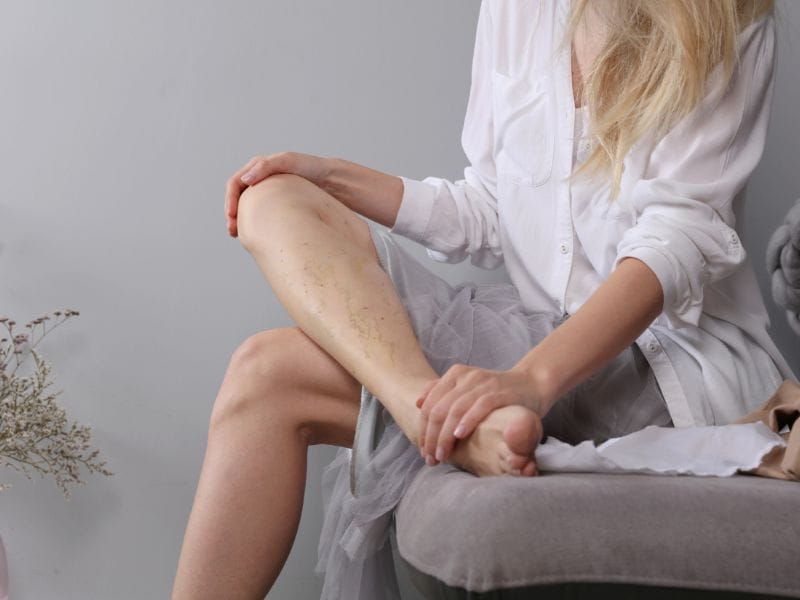
Varicose veins are a common vascular condition that affects a significant number of people, especially as they age. While varicose veins are often seen as a cosmetic concern, they can sometimes indicate more serious underlying issues. In this comprehensive guide, we’ll delve into the world of varicose veins, discussing what they are, their potential implications, and when you should start worrying about them. By the end of this article, you’ll have a clear understanding of when to seek medical attention for varicose veins and when they are simply a benign cosmetic issue.
What Are Varicose Veins?
Varicose veins, those twisted and swollen veins most commonly found in the legs, can raise concerns beyond their appearance. They result from weakened valves in the veins that hinder proper blood flow, leading to blood pooling in the veins and causing them to bulge. The causes can vary from genetic predisposition to prolonged periods of standing or sitting.
Cosmetic vs. Medical Concerns
Many individuals with varicose veins seek medical advice primarily for cosmetic reasons. These veins can be unsightly and cause self-consciousness, especially when they are easily visible. However, it’s crucial to distinguish between cosmetic concerns and potential medical issues. While minor varicose veins might only require cosmetic treatments, larger, more pronounced ones might lead to pain, discomfort, or even complications.
Recognizing Early Symptoms
Early detection of varicose veins is essential to prevent potential complications. You should pay attention to any visible changes in your veins, such as darkening or bulging. Additionally, feelings of heaviness, throbbing, or discomfort in the legs can also be early warning signs.
Potential Complications
Varicose veins can lead to more severe problems if left untreated. Blood clots, known as thrombophlebitis, can form in the affected veins, potentially causing pain and inflammation. Furthermore, the chronic pooling of blood can lead to skin changes and even ulcers, particularly near the ankles.
Risk Factors
Certain factors increase your vulnerability to varicose veins. Age plays a role, as the veins’ elasticity tends to decrease over time. Genetics also play a significant role; if your parents had varicose veins, you might be more likely to develop them. Additionally, occupations that involve prolonged periods of standing or sitting can contribute to their development.
When to Consult a Doctor
Persistent pain, discomfort, or aching in the legs may indicate a need for medical attention. If your varicose veins impact your daily life, causing limitations in movement or affecting your sleep, it’s time to seek professional advice. A medical evaluation can determine the severity of the condition and guide further steps.
Diagnostic Procedures
Medical professionals use various methods to diagnose varicose veins. Ultrasound and Doppler imaging are common techniques that allow doctors to visualize the veins and assess blood flow. In more complex cases, a venogram might be conducted, involving the injection of a contrast dye to enhance visibility.
Treatment Options
For less severe cases, lifestyle changes can alleviate discomfort. Regular exercise and maintaining a healthy weight can improve blood circulation. Compression therapy, which involves wearing specialized stockings, can also help. In more severe instances, medical interventions like sclerotherapy, endovenous laser ablation, or surgical procedures might be recommended.
Living with Varicose Veins
While medical treatments exist, lifestyle changes can significantly contribute to managing varicose veins. Elevating your legs when possible, avoiding prolonged sitting or standing, and engaging in low-impact exercise can all make a positive impact.
When to Worry About Varicose Veins: The Take Home
In conclusion, varicose veins are more than just a cosmetic issue. They can lead to discomfort, pain, and even more severe complications if left untreated. Recognizing the early signs, understanding the risk factors, and knowing when to seek medical advice are all crucial steps in managing varicose veins effectively.
FAQs: When to Worry About Varicose Veins
- Are varicose veins always a cause for concern? Not necessarily. While they can cause discomfort and lead to complications, some cases are purely cosmetic and don’t require medical intervention.
- Can exercise help prevent varicose veins? Yes, regular exercise that promotes good circulation can lower your risk of developing varicose veins.
- Is surgery the only option for severe varicose veins? No, there are various treatment options available, including less invasive procedures like endovenous laser ablation and sclerotherapy.
- Can varicose veins be completely cured? While treatment can alleviate symptoms and improve appearance, varicose veins may reoccur over time, especially if risk factors aren’t addressed.
- Is it possible to prevent varicose veins if they run in my family? While genetics play a role, adopting a healthy lifestyle, maintaining a healthy weight, and staying physically active can help reduce your risk.
DISCLAIMER: Flawsome and Fifty website does not provide medical advice
The information, including but not limited to, text, graphics, images, and other content contained on this website is for informational purposes only. No material on this site is intended to be a substitute for professional medical advice, diagnosis, or treatment. Always seek the advice of your doctor with any questions you may have regarding a medical condition or treatment before undertaking a new healthcare routine or product, and never disregard professional medical advice or delay in seeking it because of something you have read on this website.
